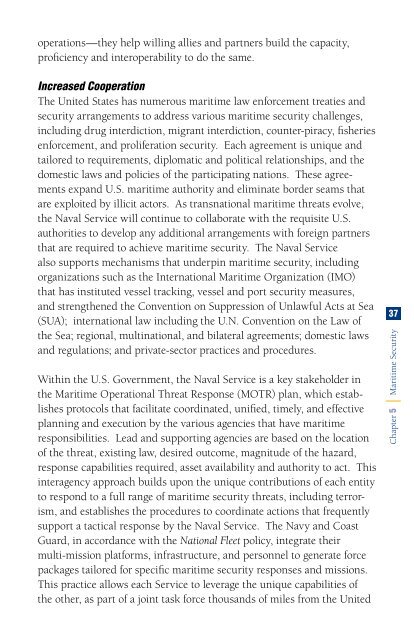Naval Operations Concept - Defense Technical Information Center
Naval Operations Concept - Defense Technical Information Center
Naval Operations Concept - Defense Technical Information Center
You also want an ePaper? Increase the reach of your titles
YUMPU automatically turns print PDFs into web optimized ePapers that Google loves.
operations—they help willing allies and partners build the capacity,<br />
proficiency and interoperability to do the same.<br />
Increased Cooperation<br />
The United States has numerous maritime law enforcement treaties and<br />
security arrangements to address various maritime security challenges,<br />
including drug interdiction, migrant interdiction, counter-piracy, fisheries<br />
enforcement, and proliferation security. Each agreement is unique and<br />
tailored to requirements, diplomatic and political relationships, and the<br />
domestic laws and policies of the participating nations. These agreements<br />
expand U.S. maritime authority and eliminate border seams that<br />
are exploited by illicit actors. As transnational maritime threats evolve,<br />
the <strong>Naval</strong> Service will continue to collaborate with the requisite U.S.<br />
authorities to develop any additional arrangements with foreign partners<br />
that are required to achieve maritime security. The <strong>Naval</strong> Service<br />
also supports mechanisms that underpin maritime security, including<br />
organizations such as the International Maritime Organization (IMO)<br />
that has instituted vessel tracking, vessel and port security measures,<br />
and strengthened the Convention on Suppression of Unlawful Acts at Sea<br />
(SUA); international law including the U.N. Convention on the Law of<br />
the Sea; regional, multinational, and bilateral agreements; domestic laws<br />
and regulations; and private-sector practices and procedures.<br />
Within the U.S. Government, the <strong>Naval</strong> Service is a key stakeholder in<br />
the Maritime Operational Threat Response (MOTR) plan, which establishes<br />
protocols that facilitate coordinated, unified, timely, and effective<br />
planning and execution by the various agencies that have maritime<br />
responsibilities. Lead and supporting agencies are based on the location<br />
of the threat, existing law, desired outcome, magnitude of the hazard,<br />
response capabilities required, asset availability and authority to act. This<br />
interagency approach builds upon the unique contributions of each entity<br />
to respond to a full range of maritime security threats, including terrorism,<br />
and establishes the procedures to coordinate actions that frequently<br />
support a tactical response by the <strong>Naval</strong> Service. The Navy and Coast<br />
Guard, in accordance with the National Fleet policy, integrate their<br />
multi-mission platforms, infrastructure, and personnel to generate force<br />
packages tailored for specific maritime security responses and missions.<br />
This practice allows each Service to leverage the unique capabilities of<br />
the other, as part of a joint task force thousands of miles from the United<br />
Chapter Maritime Security

















